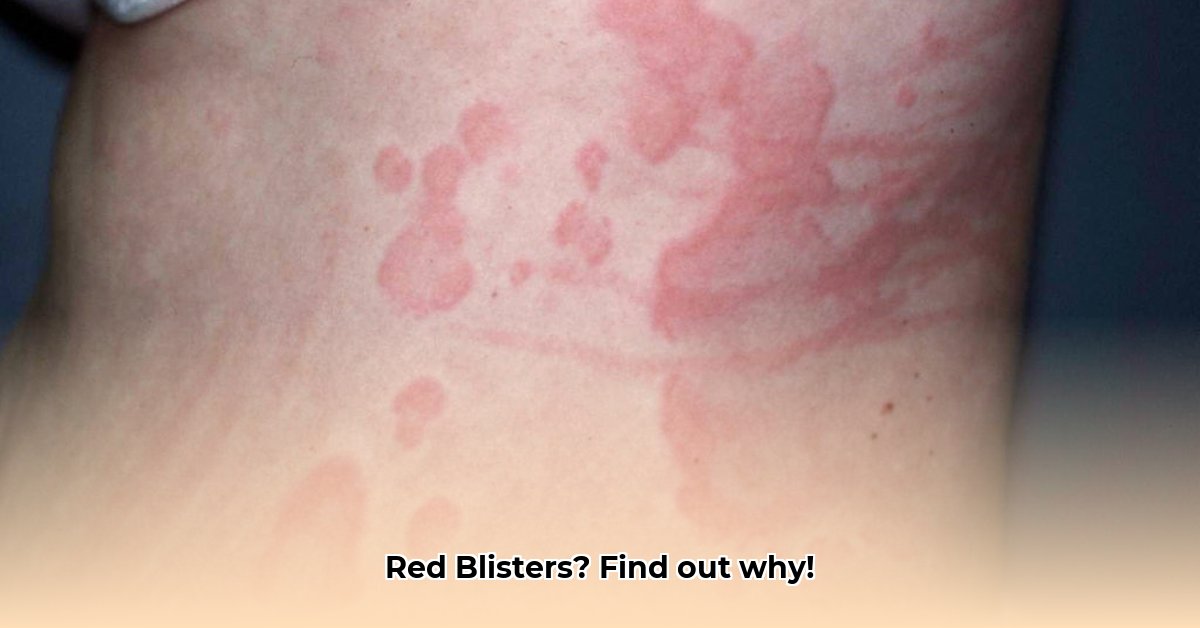
Hey there! So you've got some rode blaasjes op huid – red blisters on your skin. Don't stress too much, tjommie! Most blisters are harmless, but it's always a good idea to understand what's happening. This comprehensive guide will help you identify different blister types, understand their causes, and know when it's time to seek professional help. We'll cover home care, when to see a doctor, and how to prevent future blisters. Let's get to the bottom of this!
Verskillende Soorte Blaasjes: Ontrafel die Misterie
Red blisters can have many causes. Think of it as a detective case! The fluid inside – clear, cloudy, pus-filled, or bloody – provides vital clues. Let's look at the main types:
- Virusinfeksies (Viral infections): Think chickenpox (waterpokies) or cold sores (koorsblaasies). These often appear in groups, are small, and fluid-filled.
- Bakteriële infeksies (Bacterial infections): Impetigo is a common bacterial skin infection causing blisters, often with a honey-coloured crust.
- Swaminfeksies (Fungal infections): Athlete's foot (voetschimmel) can cause blisters, especially between toes. It usually itches, bru.
- Allergiese reaksies (Allergic reactions): Contact dermatitis, from irritants or allergens, can cause itchy, red blisters.
- Wrywing (Friction): Repeated rubbing or pressure causes friction blisters, often on feet or hands. New shoes, anyone?
- Outomatiese siektes (Autoimmune diseases): Rarely, blisters signal a serious autoimmune disease like pemphigus. This needs a specialist's attention.
Simptome en Risiko-faktore: Die Leidrade
Don't just look at the blisters. Other symptoms matter:
- Jeuk (Itching): Intense itching often points to allergies or fungal infections.
- Pyn (Pain): Severe pain might indicate a burn or serious infection.
- Koors (Fever): Fever suggests a general infection.
- Moegheid (Fatigue): Unusual tiredness can accompany viral infections or autoimmune diseases.
Consider your risk factors:
- Onlangse blootstelling aan irriterende stowwe (Recent exposure to irritants): Did you use a new cleaning product or handle something that might have irritated your skin?
- Geskiedenis van soortgelyke toestande (History of similar conditions): Have you had these blisters before? Your history is important.
- Onderliggende gesondheidstoestande (Underlying health conditions): Certain medical conditions make you more susceptible to blisters.
Tuisversorging (Home Care) en Wanneer 'n Dokter te Sien (When to See a Doctor)
For small blisters, basic self-care often suffices:
- Clean the area: Gently wash with mild soap and water.
- Keep it dry: Let it air dry, protect from rubbing.
- Avoid irritants: Stay away from things that might worsen inflammation.
- Over-the-counter remedies: Consider a topical antiseptic cream (but remember, this doesn’t treat the cause).
When to see a doctor? Don't delay if you notice:
- Large blisters.
- Fever or feeling unwell.
- A spreading infection (redness, swelling, increased pain).
- Severe pain or discomfort.
- Blisters that don't heal within a few weeks.
- Blisters accompanied by other unusual symptoms.
Immediate medical attention is crucial in these cases.
Diagnose en Behandeling (Diagnosis and Treatment)
Diagnosis involves a thorough examination. Your doctor might do tests, like a swab, to identify bacteria or fungi. Treatment depends on the cause:
- Topical creams: Corticosteroids for allergies, antifungals for fungal infections.
- Antiviral medication: For viral infections like herpes simplex.
- Antibiotics: For bacterial infections.
Referrals to specialists, like dermatologists, might be needed for complex cases or suspected autoimmune diseases. Have you considered that maybe your blisters are a cause for concern?
Voorkoming (Prevention)
Prevention often involves avoiding the underlying cause:
- Wear appropriate footwear: Crucial for preventing friction blisters on your feet.
- Avoid irritants: Protect your skin from harsh chemicals or allergens.
- Maintain good hygiene: Regular cleaning discourages fungal and bacterial growth.
Remember, proactive self-care and seeking professional help when needed are key. Don't hesitate to consult a healthcare professional if you have any concerns. Gesondheid is rykdom!
Key Takeaways: Remember These Three Things
- Many blisters are minor: Most heal on their own without fuss.
- Serious blisters need attention: Watch out for warning signs like fever or pus.
- See a doctor when concerned: Early diagnosis and treatment are vital.